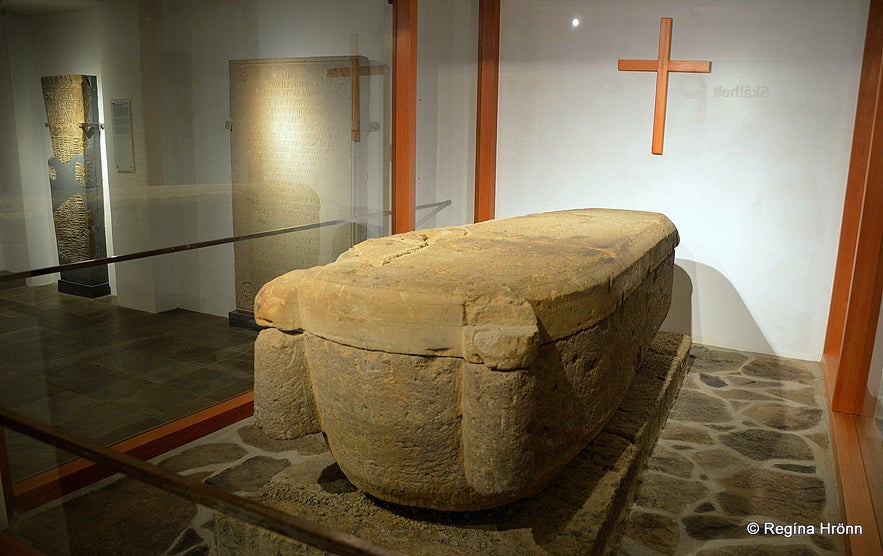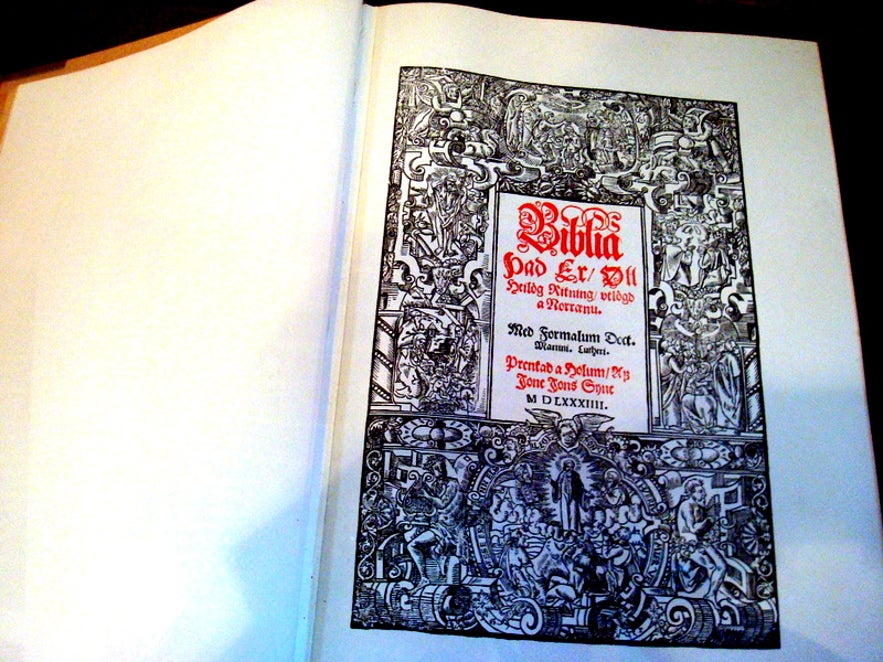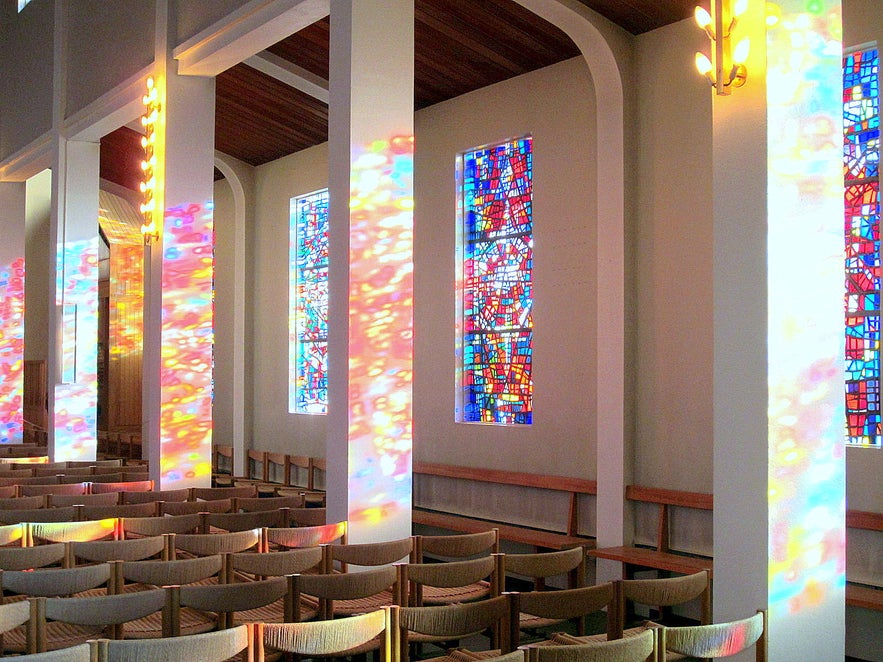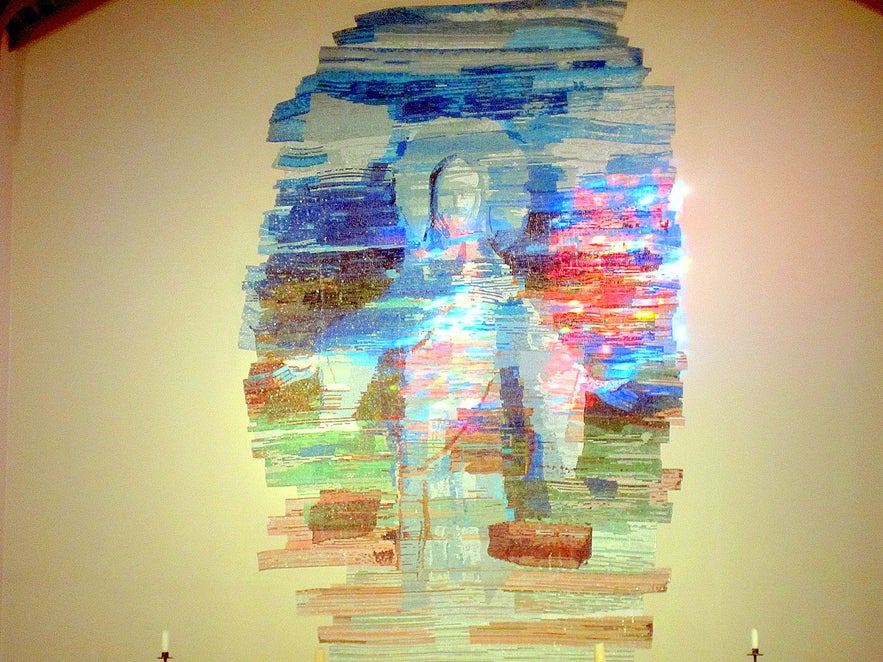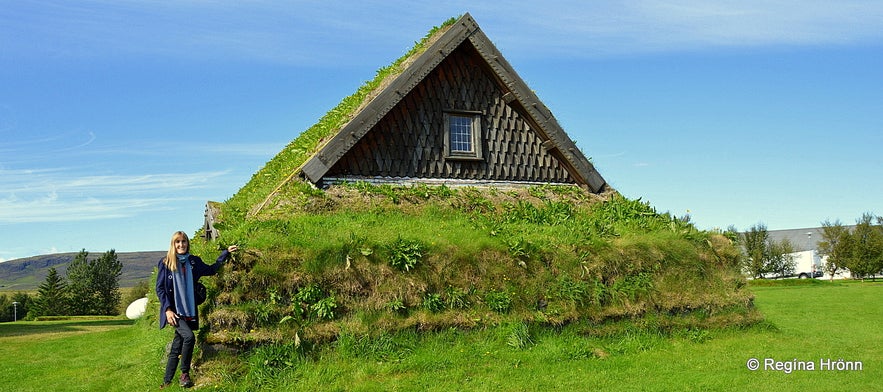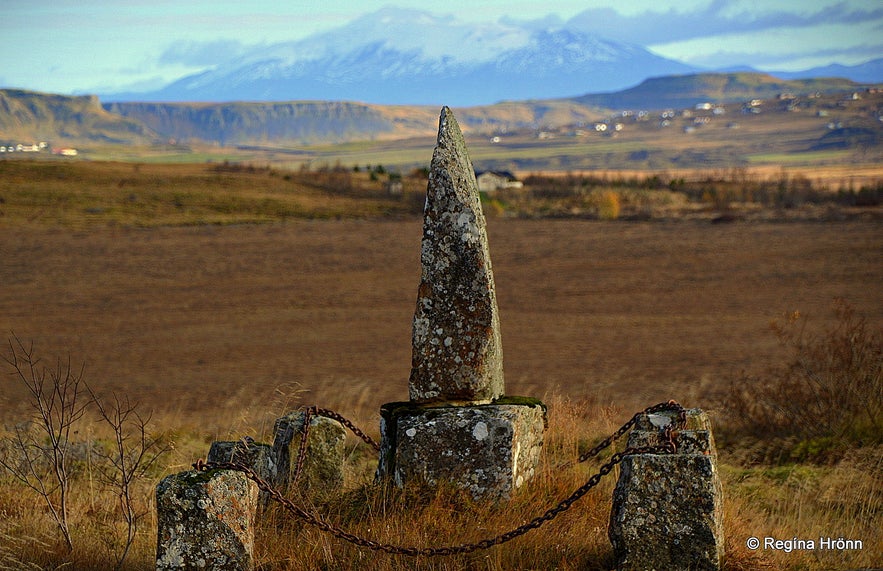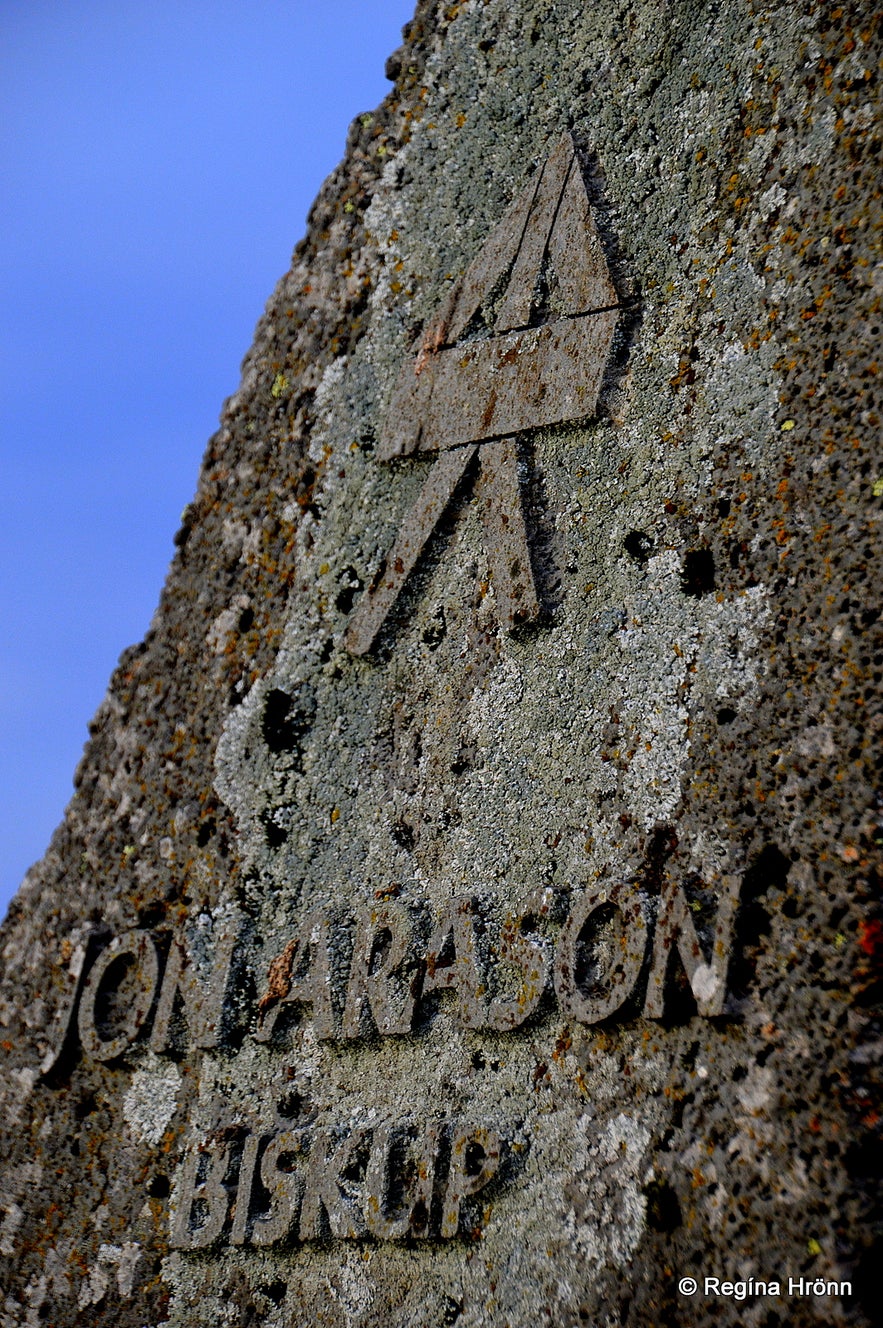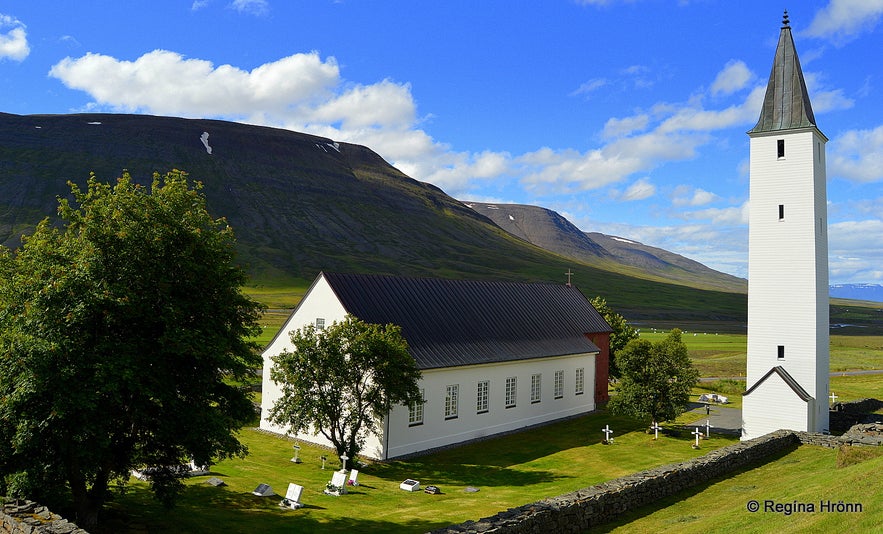
A Visit to the historic Skálholt Episcopal See in South Iceland
In my last travel-blog, I wrote about Hólar in Hjaltadalur in North Iceland, which from 1106-1801 was one of 2 episcopal sees in Iceland - the Northern seat of the bishops and the educational capital of the north.
The other episcopal see, which I am going to show you in this travel-blog, was at Skálholt in South Iceland, which is one of Iceland's most historic places and to us Icelanders a holy place, at least that is how I feel about Skálholt.
Top photo: Þór and the first bishop at Skálholt, Ísleifur, by Páll from Húsafell
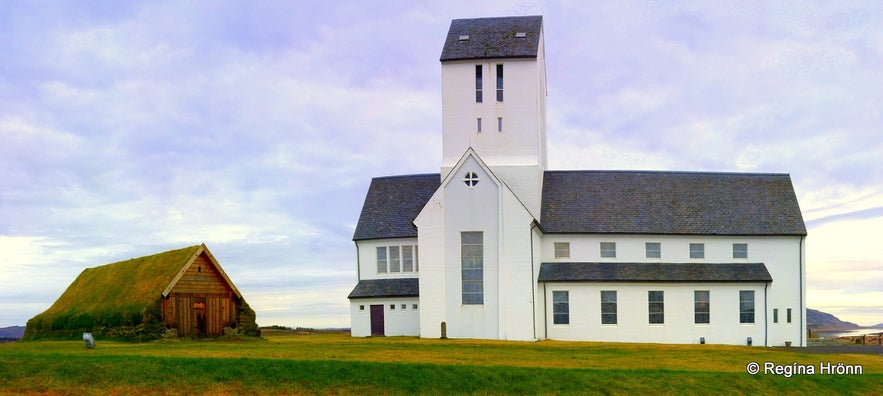
Þorláksbúð and Skálholtsdómkirkja cathedral
I am writing about Skálholt as a layman, but I have a great passion for Skálholt and try to visit it as often as I can. I can feel the heartbeat of my country and its history at Skálholt :)
I am going to tell you a little bit about its history, show you photos from some of my many visits to Skálholt, and show you some of the artifacts from Skálholt that are on display at Þjóðminjasafnið - the National Museum of Iceland.
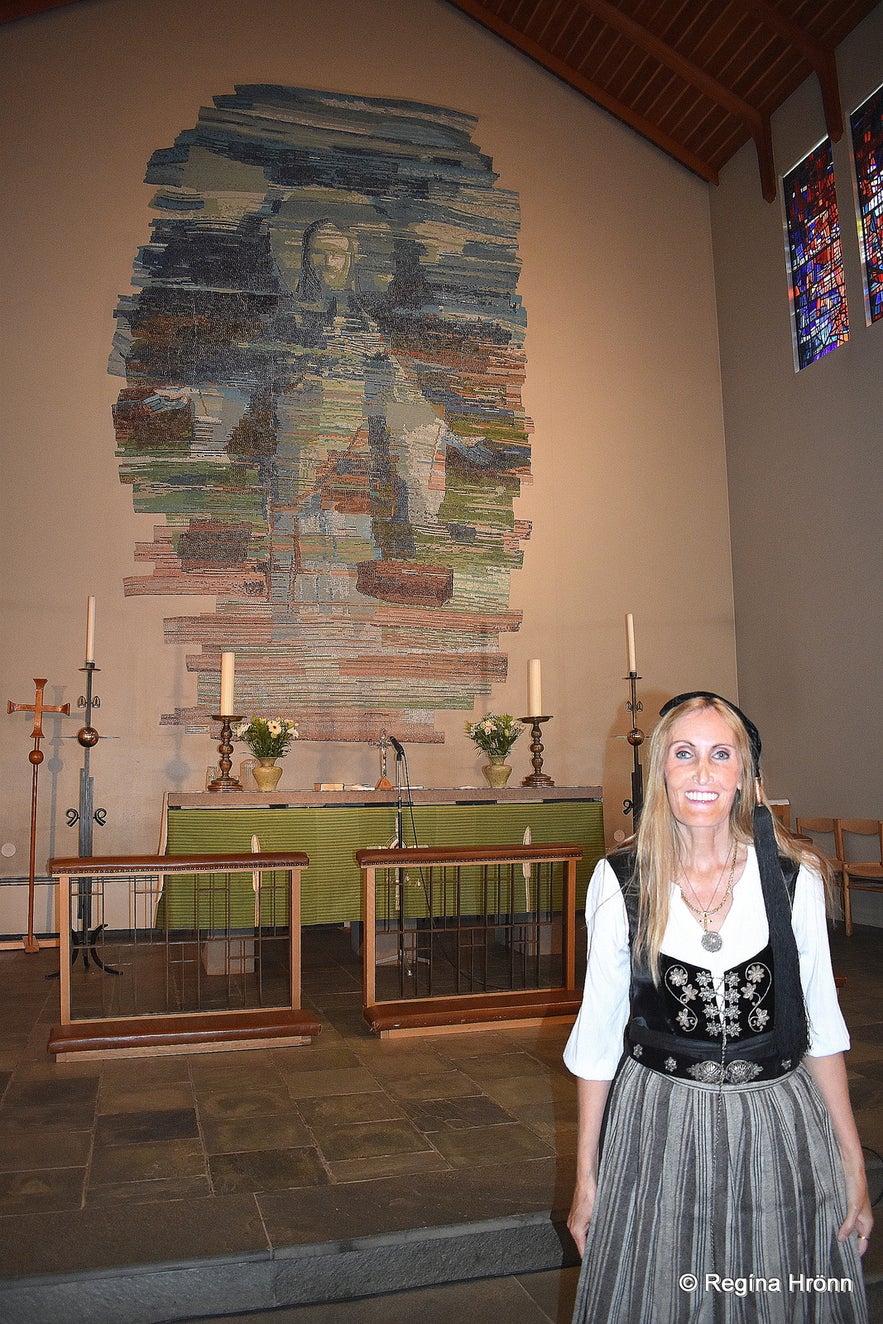 Inside Skálholtskirkja in the national costume "upphlutur" at the Skálholtshátíð annual festival
Inside Skálholtskirkja in the national costume "upphlutur" at the Skálholtshátíð annual festival
The heartbeat of Iceland could for sure be heard at Skálholt for many centuries, as it was the center of ecclesiastic power in Iceland for 740 years, from 1056-1796.
The first bishopric was founded here in 1056, with the first bishop, Ísleifur Gissurarson, taking the seat from 1056-1080.
Ísleifur was the son of Gissur hvíti, who was the son of Teitur Ketilbjarnarson, who built the first farm at Skálholt. Gissur hvíti then built the first church at Skálholt. After Ísleifur died his son Gissur became a bishop at Skálholt from 1082-1118.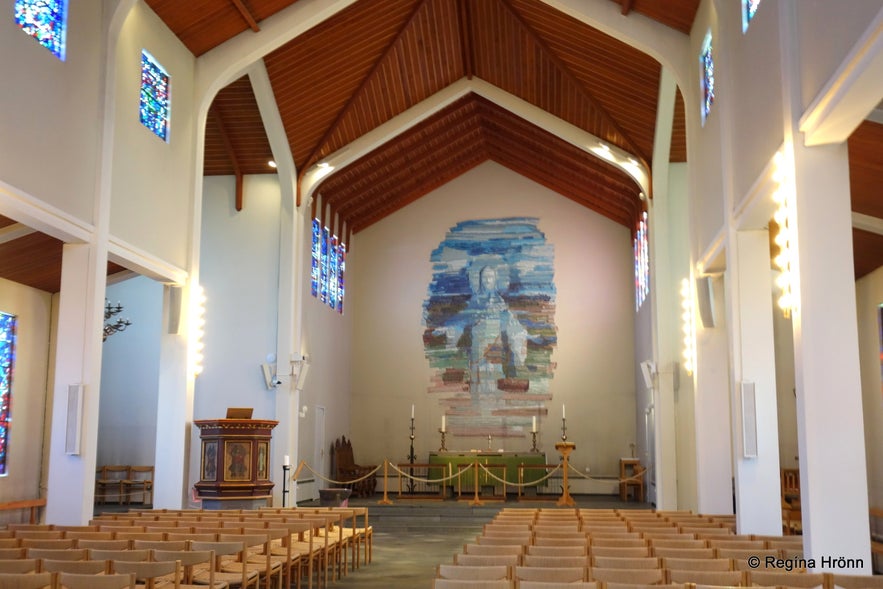 Inside Skálholt cathedral
Inside Skálholt cathedral
From then on Skálholt became the center of learning, culture, and worldly power in Iceland.
Thirty-two Catholic bishops sat here until the Reformation to Lutheranism at Skálholt in 1540. And many churches were built at Skálholt.
The Reformation was not done peacefully in Iceland and the last Catholic bishop, Jón Arason at Hólar, and his two sons, Björn and Ari, were beheaded here at Skálholt in 1550.
I tell you about this tragic event, a little bit further in this travel-blog.
 Dómkirkjan - Reykjavík cathedral
Dómkirkjan - Reykjavík cathedral
After the Reformation, 13 Lutheran bishops sat at Skálholt until 1796 when the bishopric was moved to Reykjavík cathedral, after a big earthquake in 1784 ruined all the buildings at Skálholt apart from the cathedral.
More tragic events attributed to the bishopric being moved from Skálholt, as the massive volcanic eruption called the Skaftáreldar fires started in 1783.
During this powerful volcanic eruption, 70% of the stock in Iceland died due to the toxic sulphuric dioxide mist and 10,000 people died (20% of the nation) of outbreaks of diseases and famine. Times were hard for sure for the Icelandic nation back in those dreadful days.
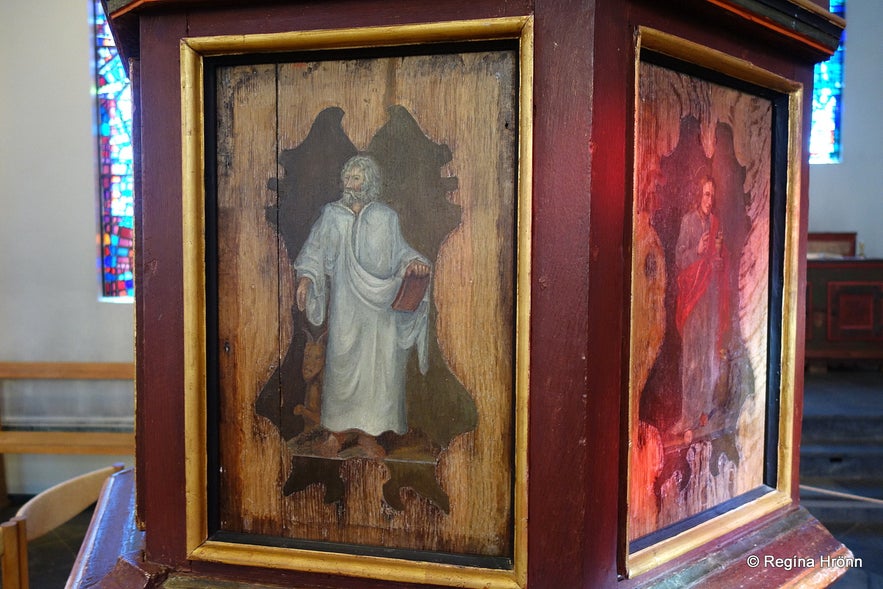 The old pulpit in Skálholtskirkja cathedral dates back to the 17th century
The old pulpit in Skálholtskirkja cathedral dates back to the 17th century
In 1802 Skálholt was sold at an auction, the land, the cathedral, the artifacts, everything - and almost 750 years of glory at Skálholt ended.
I am glad that some of the old artifacts found their way to the National Museum of Iceland and are on display there as I show you later on in this travel-blog.
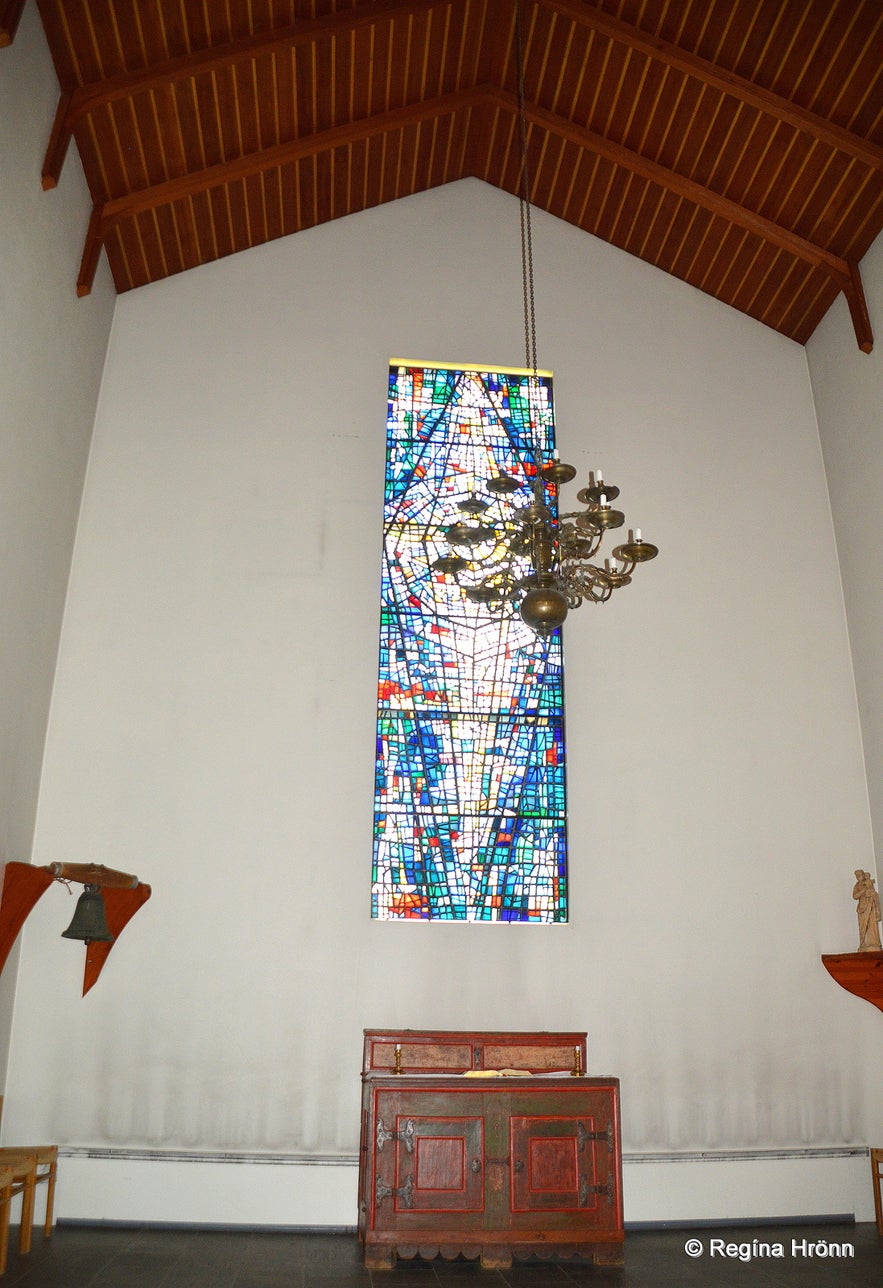 The old altar from Brynjólfskirkja cathedral in the north transept
The old altar from Brynjólfskirkja cathedral in the north transept
It wasn't until 1963 that the new cathedral at Skálholt was consecrated, after talks about reviving the glory of Skálholt.
The cornerstone was put in its place in 1956 on the millennium of the first bishopric at Skálholt. I am so glad that Skálholt was revived.
The new Skálholtsdómkirkja cathedral got several gifts from our neighbouring countries. The baptismal font in my photo below is made from stone from the Farao islands. The Faroese church donated the baptismal font to the Skálholtskirkja cathedral at the consecration.
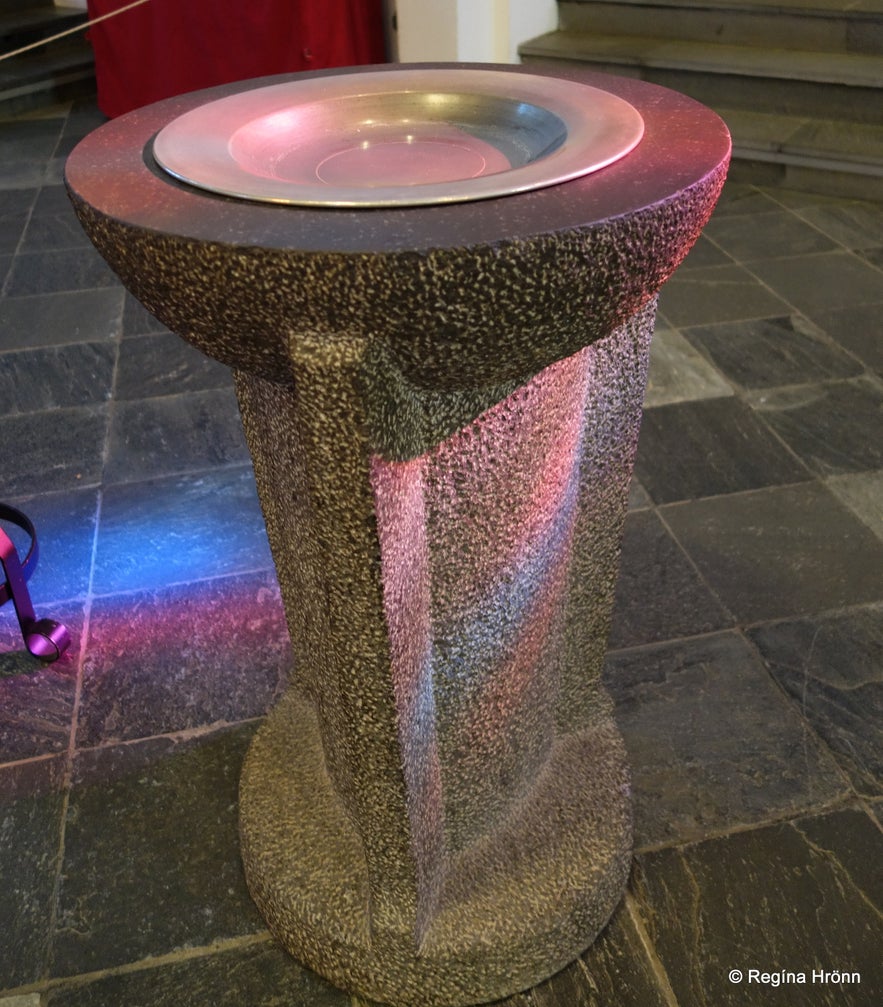 The baptismal font in Skálholtsdómkirkja cathedral
The baptismal font in Skálholtsdómkirkja cathedral
You will find some of the old artifacts in the new cathedral, f.ex. the old pulpit, which dates back to the 17th century and was in the Brynjólfskirkja cathedral. Also, the old altar is from Brynjólfskirkja cathedral.
And the copper chandelier, which you can see in my photo above, that bishop Brynjólfur had made for his cathedral.
Brynjólfskirkja was named after bishop Brynjólfur Sveinsson, who was the bishop at Skálholt from 1639-1674.
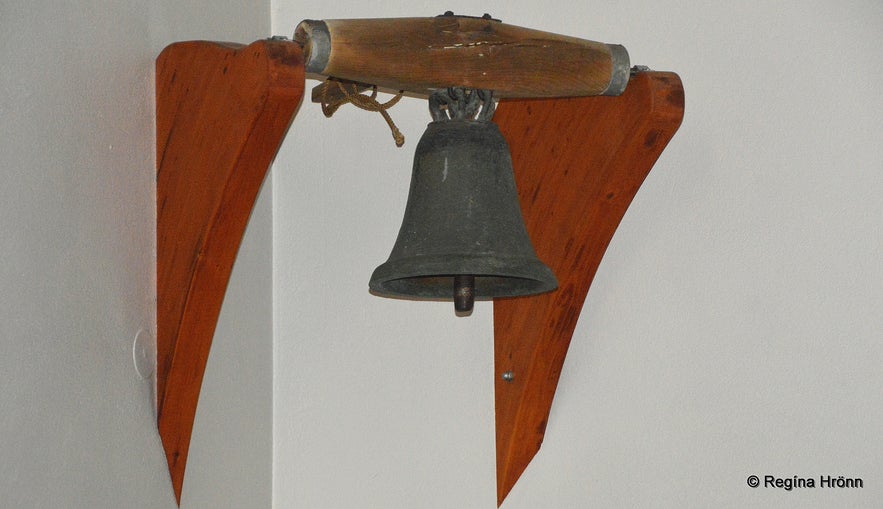 The old church bell inside Skálholt cathedral
The old church bell inside Skálholt cathedral
Other old artifacts in the new Skálholtsdómkirkja cathedral are f.ex. the old church bell in the north transept, which dates back to the period 1150-1300. It has still a lovely sound.
There are 5 church bells in the church tower, and one of them is brand new.
At the Skálholtshátíð festival in 1956, the Nordic countries donated church bells to Skálholt, we got 2 church bells (which weigh 700 kilos each) from Sweden, one from Norway, one from Finland, and in 1961 we got one from Denmark. It was the Danish church bell (500 kilos) that fell and broke.
In 2022 the old church bell that fell to the ground 2 decades ago and broke was replaced. This is the sound of the church bells at Skálholt after the new one was added in June 2022.
The stone sarcophagus of bishop Páll Jónsson in the crypt
The sarcophagus of Páll in the crypt at Skálholt
A sarcophagus was unearthed on the 21st of August 1954 during the excavation for the foundations of the new cathedral, containing the remains of our bishop Páll Jónsson, who died on the 29th of November, 1211.
When Páll was buried the heavens are said to have wept, and then the sarcophagus was opened on the 30th of August, 1954 the heavens opened and it started raining cats and dogs, Kristján Eldjárn tells us (ref. Hundrað ár í Þjóðminjasafni).
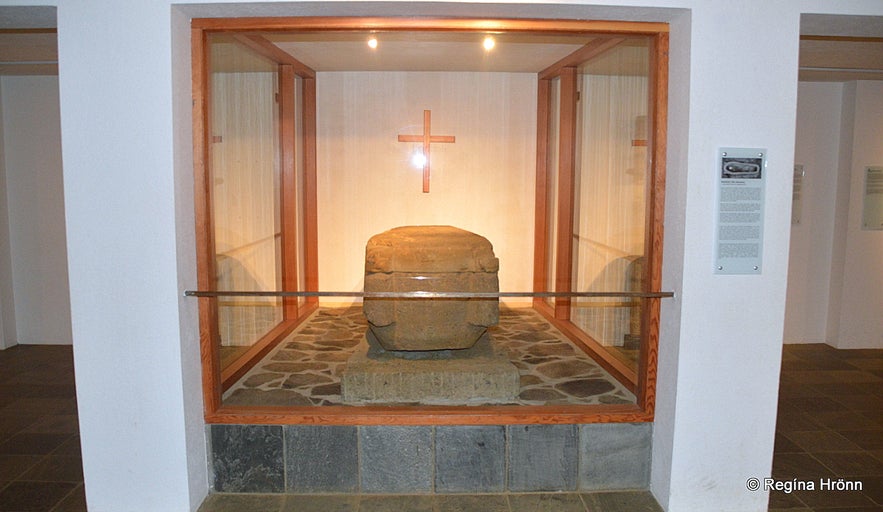 The stone sarcophagus in the crypt
The stone sarcophagus in the crypt
Páll Jónsson was the bishop at Skálholt from 1195 until he died in 1211. He was the son of the noted Jón Loftsson at Oddi, who fostered Snorri Sturluson.
And his mother was Ragnheiður the sister of Bishop Þorlákur helgi. They were of the Clan of Oddaverjar, and were some really powerful and wealthy people back in their days.
The sarcophagus is by far the most important old relic to be found at Skálholt and is on display in the church crypt. The sarcophagus is made of palagonite, and is the only sarcophagus we have found in Iceland.
And it is the only sarcophagus mentioned in written sources, in Biskupasögur - the account about Bishop Páll.
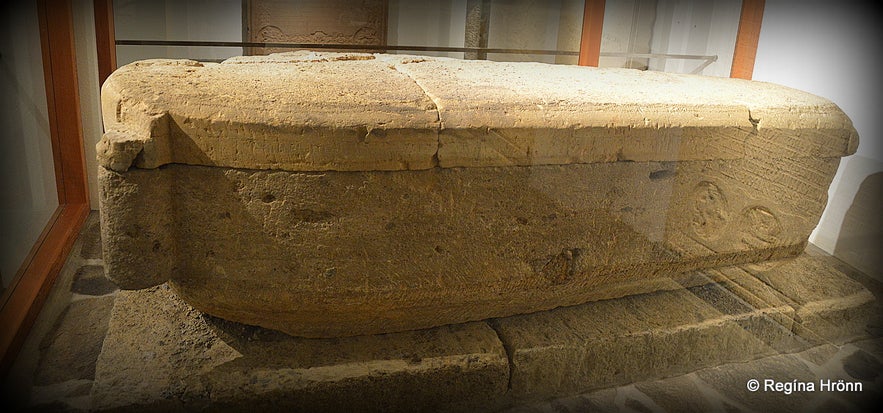 The stone sarcophagus
The stone sarcophagus
At Þjóðminjasafnið - the National Museum of Iceland you will find a crosier (bagall) which was found with the bones of Páll in the sarcophagus - Bagall - Sarpur. It lay by his right shoulder and a metal tip of the crosier lay by his feet.
It is made of a walrus tusk and is believed to be English, made around 1200.
Only two crosiers have been found, this one and another one (believed to date back to 1100) was found in 1957 at Þingvellir - Tákross - Sarpur. But the crosier at Skálholt is the only one that we know for sure belonged to a known bishop.

A crosier (bagall) found with the remains of Páll - is on display at the National Museum - 12.5 cm
Another exquisite walrus tusk crosier was made in Iceland by Margrét "haga" (1170-1220). Bishop Páll sent it to the Archbishop of Nidaros (the medieval name of Trondheim).
Margrét "haga" was the wife of a minister at Skálholt and a well-known artist who lived at Skálholt when Páll was a bishop and is believed to have carved many a beautiful artifact, including possibly this crosier and the famous Lewis chessmen.
But we can never know that for sure, so we are only speculating.
In the crypt of Skálholt
In the crypt, you will also find 2 Icelandic tombstones and foreign tombstones of 5 bishops and 1 councilor.
For over 100 years, it became "fashionable" for bishops to buy foreign tombstones, the oldest one of these tombstones is from 1697, and the "youngest" one is from 1796.
The 13th-century tunnel at Skálholt
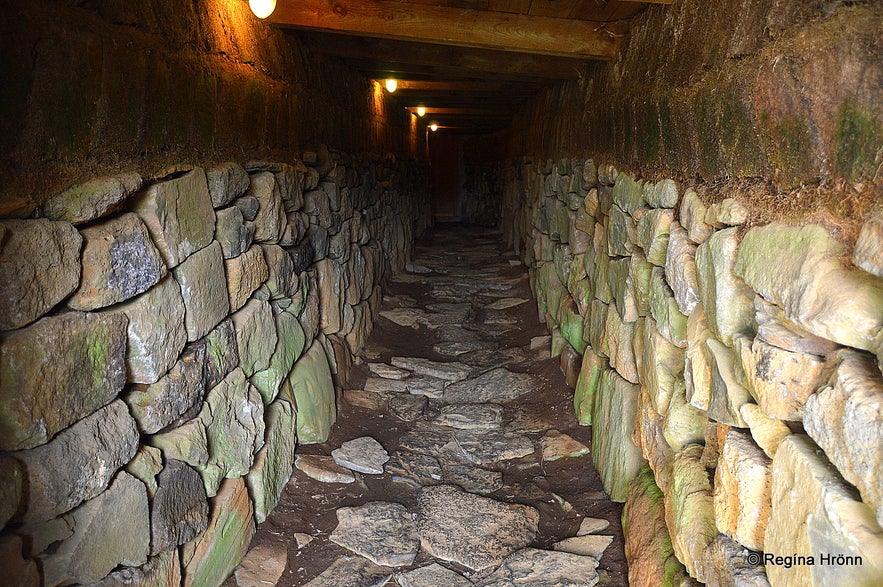
The medieval tunnel at Skálholt
A 13th-century tunnel leads to the crypt/cellar. In the olden days, the tunnel was used as a tunnel between the Cathedral and the school.
The tunnel was rebuilt in 1958 in the image of the old tunnel, so walking through it is like walking through a tunnel from the middle-ages.
The medieval tunnel is mentioned in the Saga of the Sturlungs, when Órækja Snorrason, the son of the great Snorri Sturluson at Reykholt, attacked Gissur Þorvaldsson here at Skálholt in January 1242.
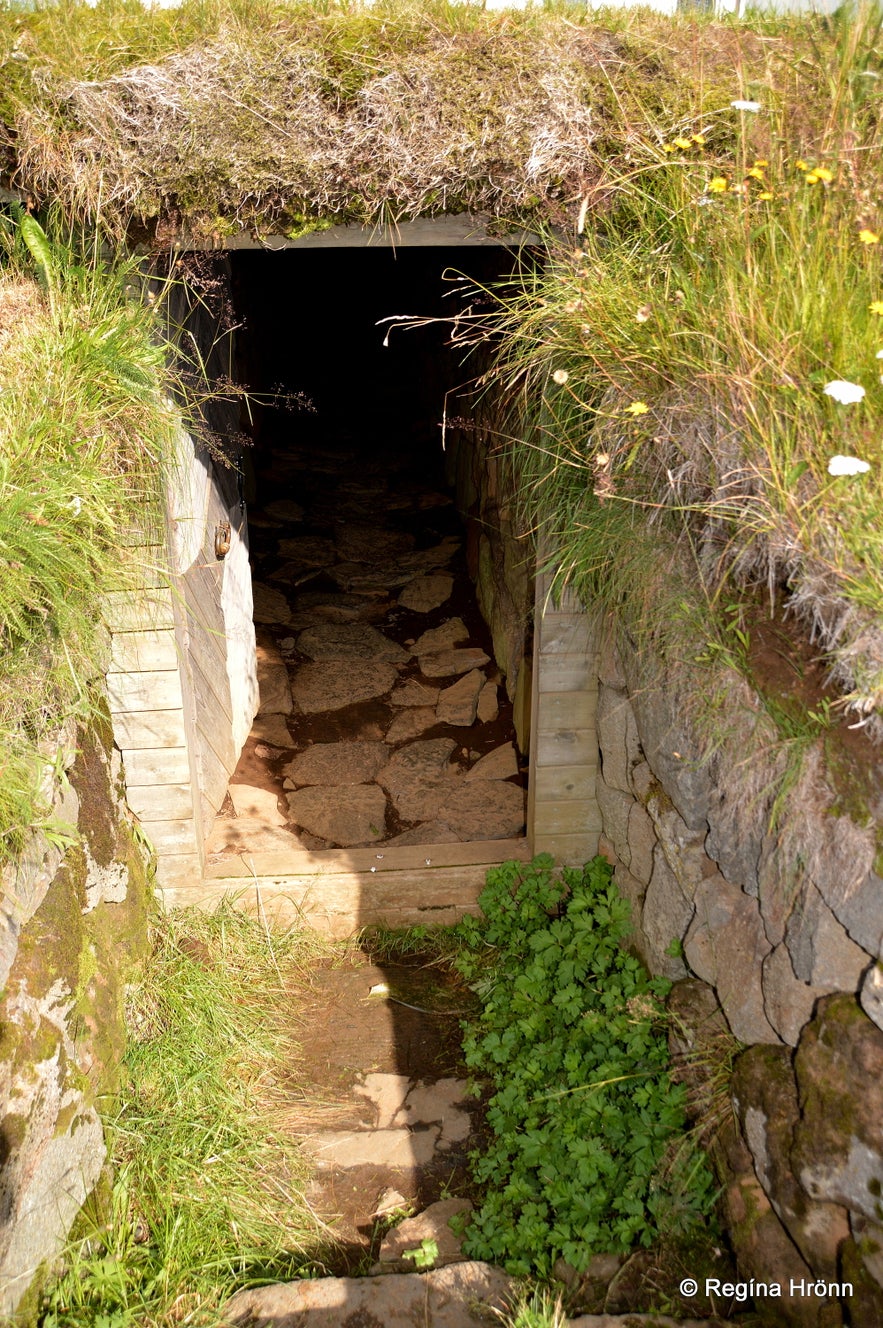
The outside entrance to the medieval tunnel at Skálholt
Gissur the Chieftain of the Clan of Haukdælingar had had his ex-father-in-law, Snorri Sturluson, killed on September 23rd, 1241. Órækja wanted revenge for his father.
I have written a travel-blog about both Snorri Sturluson and the bloody Viking battles in Skagafjörður.
These most powerful Viking clans in Iceland fought each other and their blood relatives. Órækja was, by the way, married to Arnbjörg, the sister of Kolbeinn ungi, the Chieftain of the Clan of Ásbirningar up north.
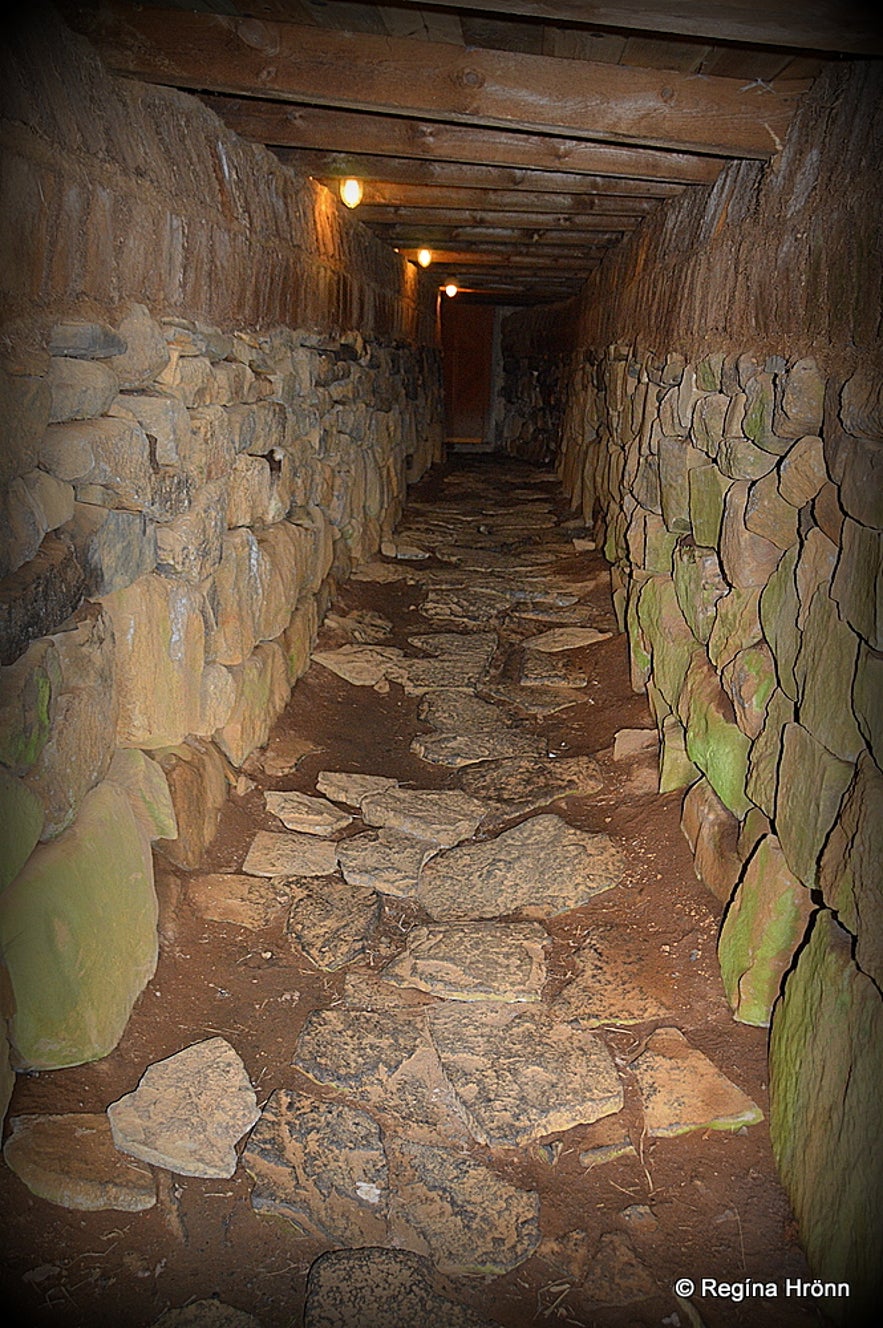 I bet you can understand how a child would find it scary to walk through this old tunnel
I bet you can understand how a child would find it scary to walk through this old tunnel
I first visited the crypt/cellar when I was 7 years old and was staying at a Christian summer camp by Skálholt. We were told scary stories about this medieval tunnel leading to the coffin with the remains of a bishop.
I found it so scary back then that I didn't visit the cellar again until 35 years later. It was less scary when I visited it for the second time ;)
The exhibition in the crypt is run by the National Museum of Iceland and there is a small entrance fee.
Guðbrandsbiblía bible at Skálholt
On display inside the Cathedral is the Bible of bishop Guðbrandur, called Guðbrandsbiblía in Icelandic, published in 1584.
This Bible is the first edition of the Icelandic Bible and one of the few remaining copies still in its original bindings, so it is a great treasure to us.
Inside Skálholtskirkja - beautiful light from the stained glass windows
Bishop Guðbrandur Þorláksson (1541-1627) at Hólar in Hjaltadalur published this Bible in Icelandic and it was indeed a great achievement and played a big role in conserving the Icelandic language, plus allowing the nation to get the knowledge of Christianity in their own language.
There is a small museum on the second floor of the church displaying books that were printed in the 18th century, among them the 1st book printed in our language. I have heard that a Gestastofa - Visitor center will be opened soon where the books will be on display.
 The beautiful stained glass windows in Skálholtsdómkirkja cathedral
The beautiful stained glass windows in Skálholtsdómkirkja cathedral
You will for sure notice the beautiful stained glass windows and an altarpiece of Christ when you enter the cathedral.
Both the many (43) stained glass windows and the altarpiece are made by Icelandic women artists.
The windows are a gift from Danish merchants and are made by the artist Gerður Helgadóttir.
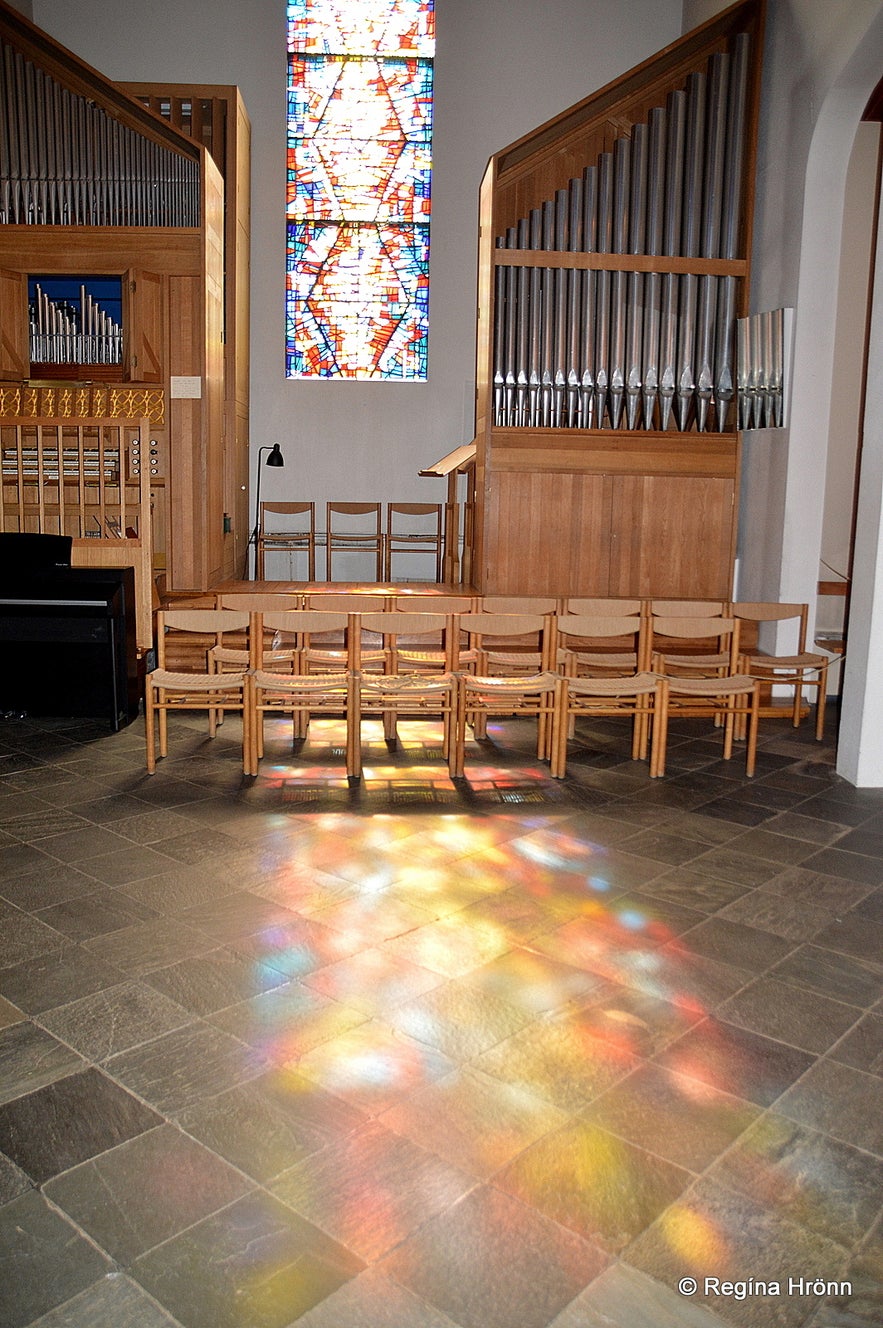
The windows reflect a beautiful light when the sun is shining
The beautiful stained glass windows show the story of the Salvation.
When the sun shines directly through the stained glass windows the interiors of the cathedral turn into a magical multi-coloured wonderland.
The altarpiece of Christ at Skálholtskirkja cathedral
The mosaic altarpiece is made by another of our female artists, Nína Tryggvadóttir.
Even the altarpiece of Christ reflects the colours of the windows, making it even more beautiful.
I have knelt in awe in front of the altar more than once when I have been here alone. I feel a strong energy in Skálholt and sometimes it is so strong that it is just overpowering.
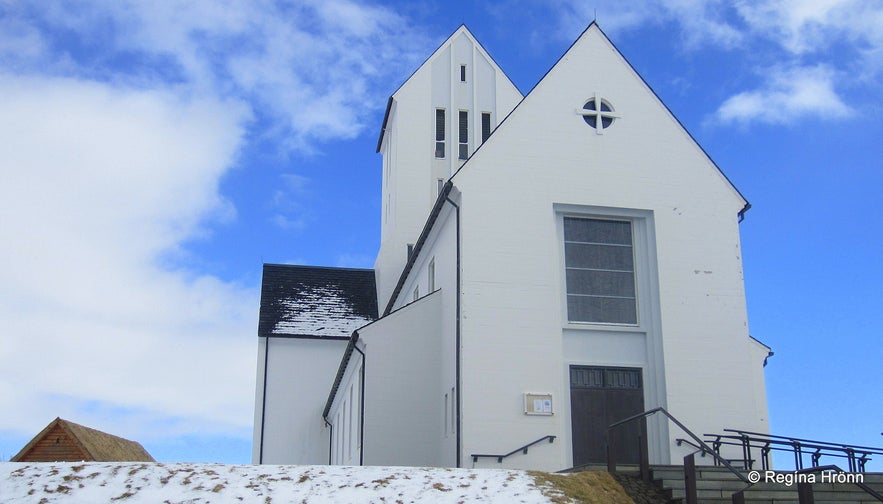
Skálholt in the wintertime
Twice I have been flat on the floor in front of the altar, and on one occasion I knocked my head hard on the stone floor when I lay there with my arms stretched out ;)
Why I feel I have to do this I don't know, but there is a strong spiritual power at work here that is stronger than me.
The archaeological site at Skálholt

Parts of the archaeological site at Skálholt - the Bishop's quarters
An archaeological site can be visited next to the Cathedral and some interesting old relics have been discovered there.
Some artifacts that have been discovered during the excavation are now on display at our National Museum in Reykjavík.
The archaeological site contains ruins from the 17th and 18th centuries and has been marked with rooms that have been unearthed there.
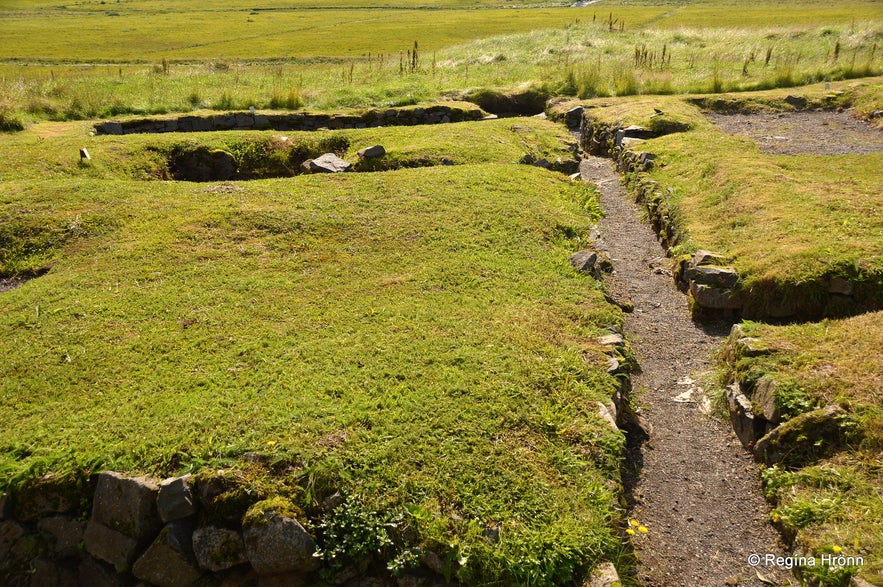
The archaeological site
You will find a dormitory, school, whey store, refectory, food store, meat store, children's room, kitchen, court, library, and the Bishop's quarters.
When I walked through the archaeological site I found such strong energy coming through the sole of my feet that it almost felt like I was walking on fire.
I sometimes feel such strong energy when I am visiting historic sites. What is it that I am feeling?
Skálholtskaleikurinn - the Chalice from Skálholt
 It is so difficult to photograph the artifacts at the National Museum of Iceland as they are behind glass
It is so difficult to photograph the artifacts at the National Museum of Iceland as they are behind glass
There are several artifacts from Skálholt at Þjóðminjasafnið - the National Museum of Iceland. The chalice in my photo above is sometimes referred to as Kaleikurinn góði - the Good chalice.
The patine beside it is also from Skálholt. You can see beautiful photos of both the chalice and the patina at Sarpur - Skálholtskaleikur.
Bishop Árni Helgason bought the chalice for Skálholt after the cathedral at Skálholt burnt down in 1309, so the chalice most likely dates back to around 1300.
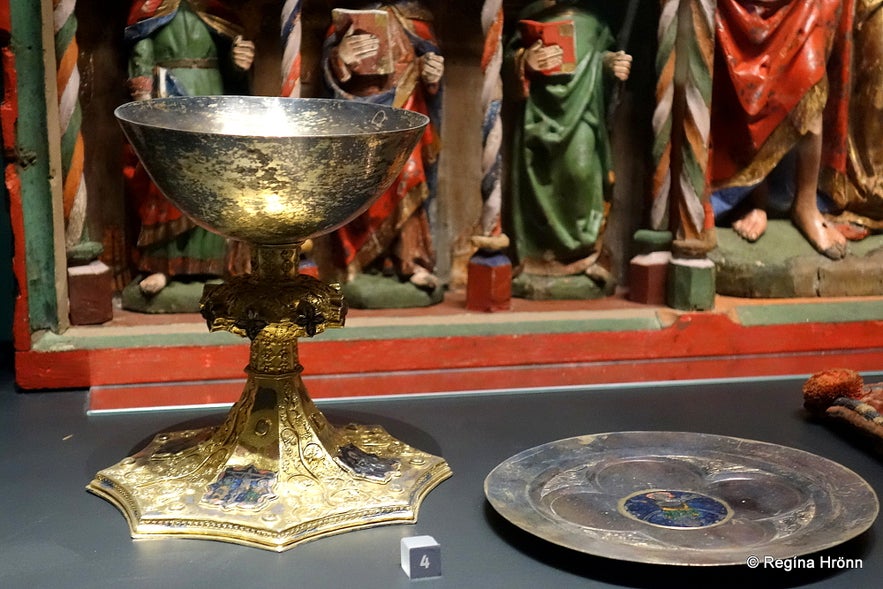 The chalice and patina
The chalice and patina
Árni built a new cathedral, which was consecrated in 1311, called Árnakirkja cathedral, which was the finest church in Iceland until it burnt down in 1527.
The chalice was bought from the owners of Skálholt and given to Dómkirkjan cathedral in Reykjavík back in 1874 after a foreigner had wanted to buy it from Skálholt.
It has belonged to the National Museum of Iceland since 1884 (ref. Hundrað ár á Þjóðminjasafni - Kristján Eldjárn).
Skálholtskaleikurinn chalice is the most precious chalice at the National Museum of Iceland, but you can see several beautiful chalices at the museum, along with other artifacts from Skálholt.
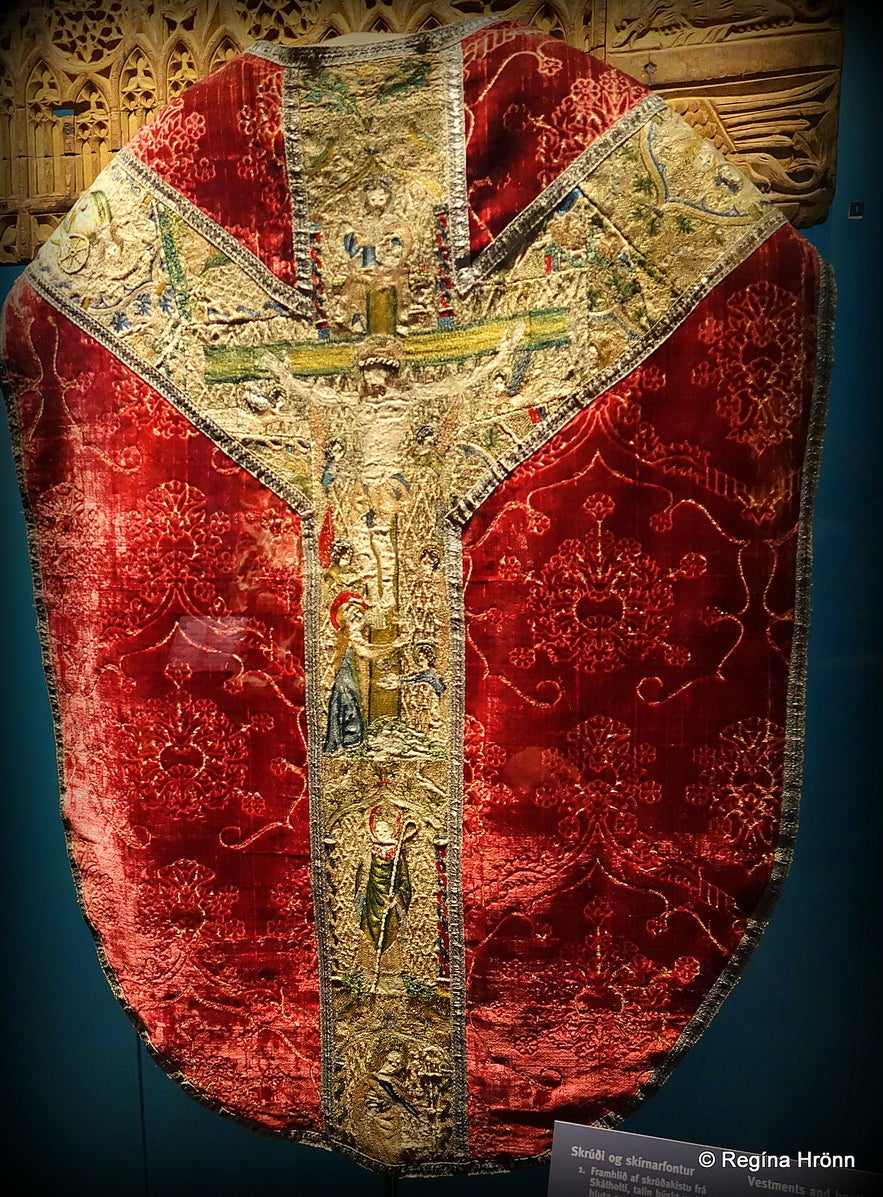 A chasuble from Skálholtsdómkirkja cathedral at the National Museum
A chasuble from Skálholtsdómkirkja cathedral at the National Museum
In my photo above you can see a beautiful chasuble from Skálholtsdómkirkja cathedral, which is on display at the National Museum.
The golden cross on the chasuble is much older than the red velvet chasuble, for more details see Sarpur.
It is my favourite museum in Iceland and I recommend visiting it, if you want to see old artefacts and some Viking stuff we have unearthed.
Þorláksbúð
Þorláksbúð hypothesis house
Þorláksbúð is a new addition to the buildings and Cathedral at Skálholt, built in 2011-2012.
It is a hypothesis house, built by the ruins of the old Þorláksbúð, which was a temporary chapel, built after the Árnakirkja church burnt down in 1527.
Þorláksbúð might have been in use for some 250 years, from approximately 1530-1784.
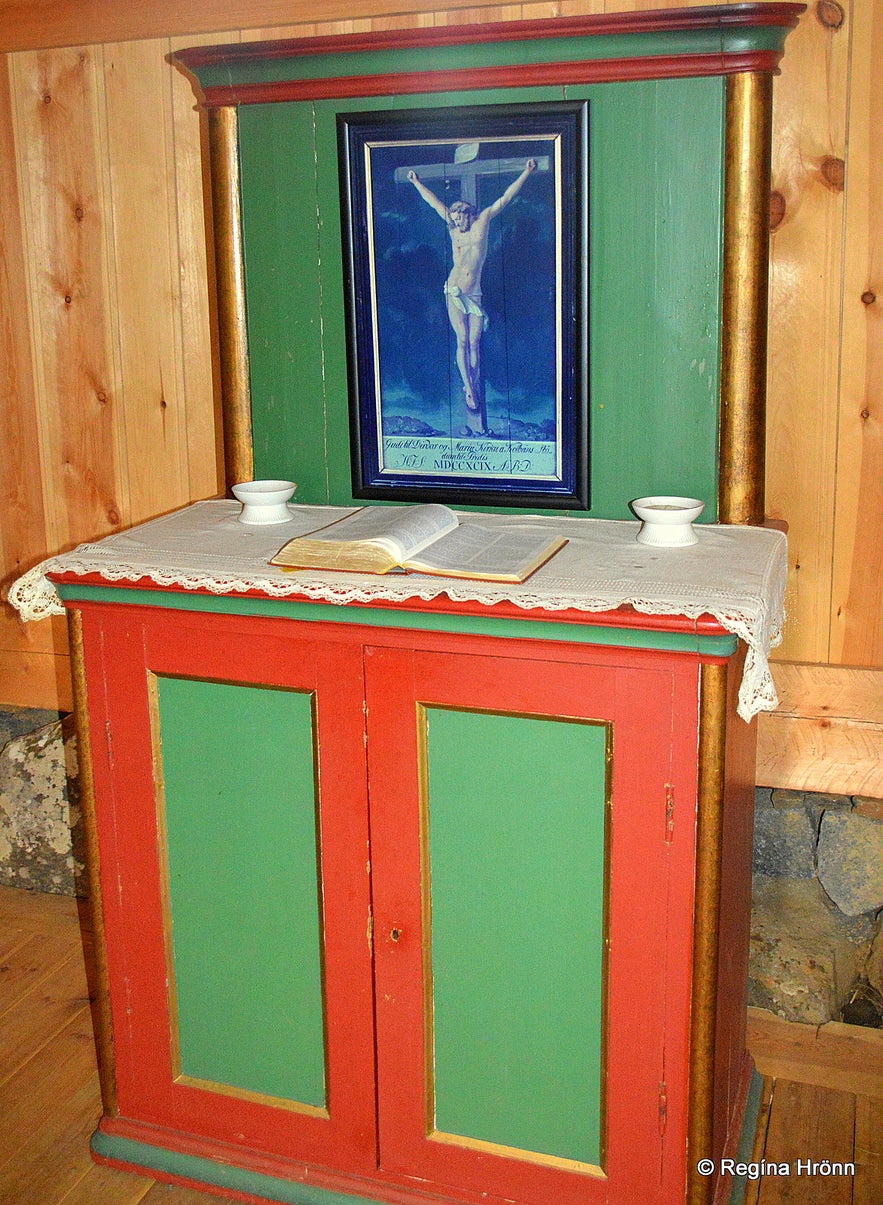
Inside Þorláksbúð
Þorláksbúð is named after Þorlákur helgi - St. Thorlak - who was the bishop at Skálholt in 1178-1193. Þorlákur helgi was the uncle of bishop Páll Jónsson who was buried in the sarcophagus.
Þorláksbúð was then later used as a storehouse.
There have been talks about building a hypothesis cathedral there, in the liking of one of the massive timber churches in Skálholt in the middle ages.
But seeing that Skálholt is a holy place I don't think this idea will come to fruition.
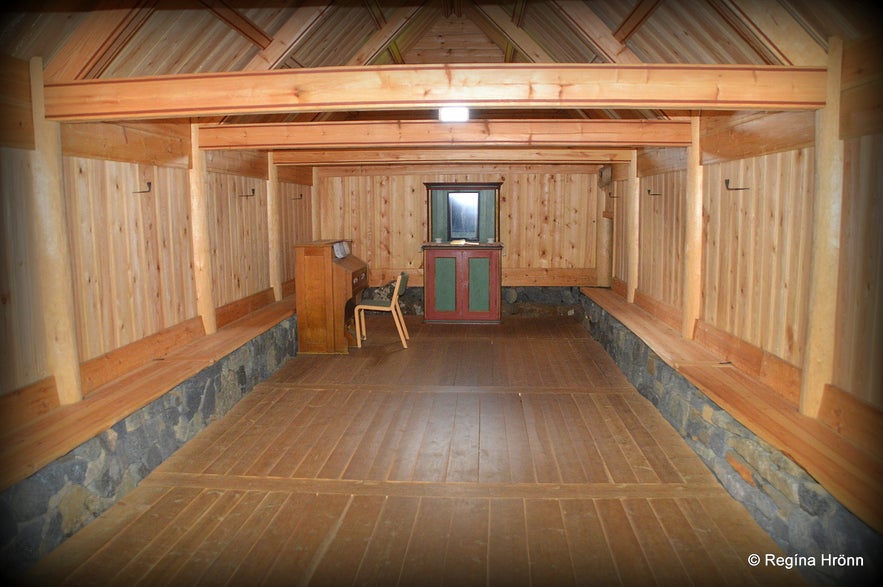
Inside Þorláksbúð
There has been a lot of controversy regarding Þorláksbúð, as some people think it ruins the image of the holy place of Skálholt, especially as this is a preserved area.
And that it should not be built right on top of the ruins, but in another place, like the hypothesis house Þjóðveldisbærinn in Þjórsárdalur valley.
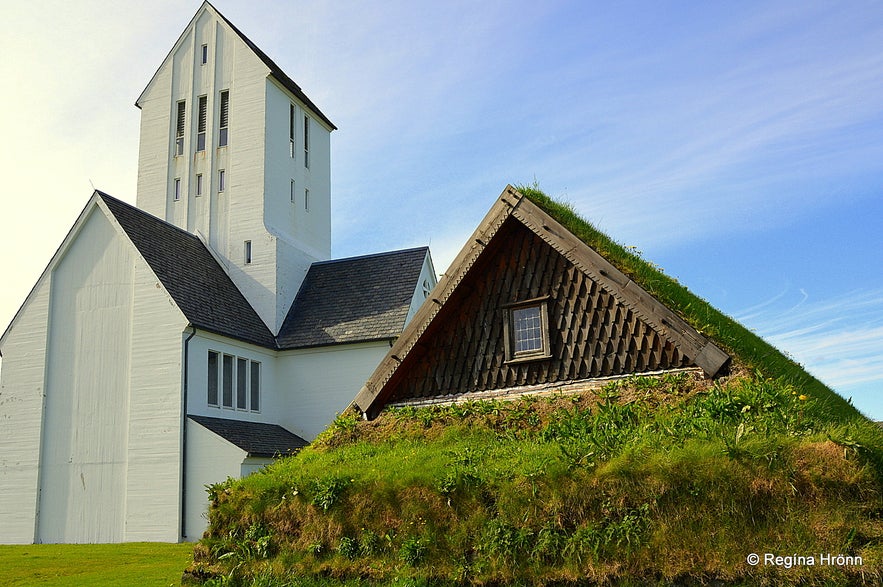
Þorláksbúð and Skálholtskirkja
I think it looks quite interesting and I am happy with this new addition.
And I know that tourists visiting Skálholt find it very interesting. All Icelanders used to live in turf houses and we have only a few of them left.
I have written another travel-blog about the remaining turf houses and turf structures in Iceland:
A List of the beautiful Icelandic Turf Houses, I have visited on my Travels in Iceland
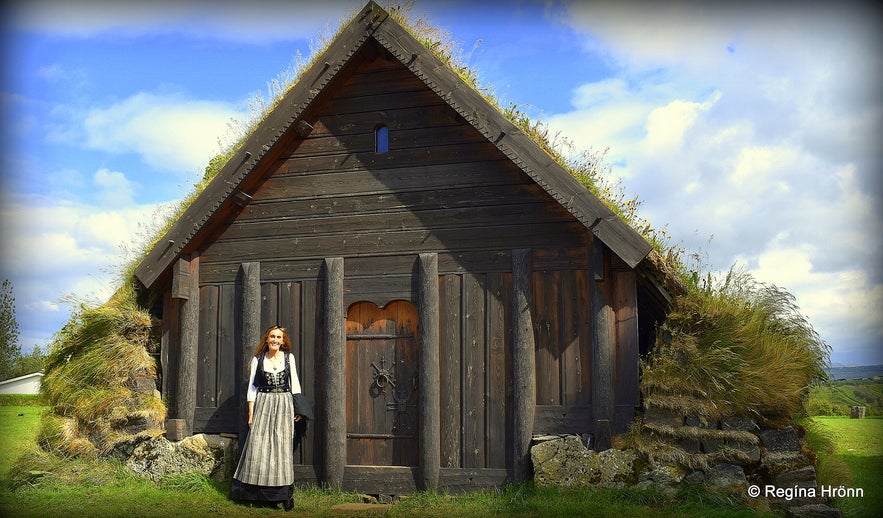 I had a photo taken in front of Þorláksbúð at Skálholtshátíð - the annual festival at Skálholt
I had a photo taken in front of Þorláksbúð at Skálholtshátíð - the annual festival at Skálholt
Next to Þorláksbúð is the grave of bishop Brynjólfur Sveinsson (1605-1675) and his daughter Ragnheiður Brynjólfsdóttir (1641-1663).
Brynjólfur Sveinsson was the bishop of Skálholt from 1639-1674 as I told you earlier.
On the memorial plaque is written: children, 3 stillborn, 2 died in infancy. Then his daughter Ragnheiður, who was 21 when she died. His son Halldór was 24 when he died. Margarét was the wife of Bishop Brynjólfur and died 5 years before him.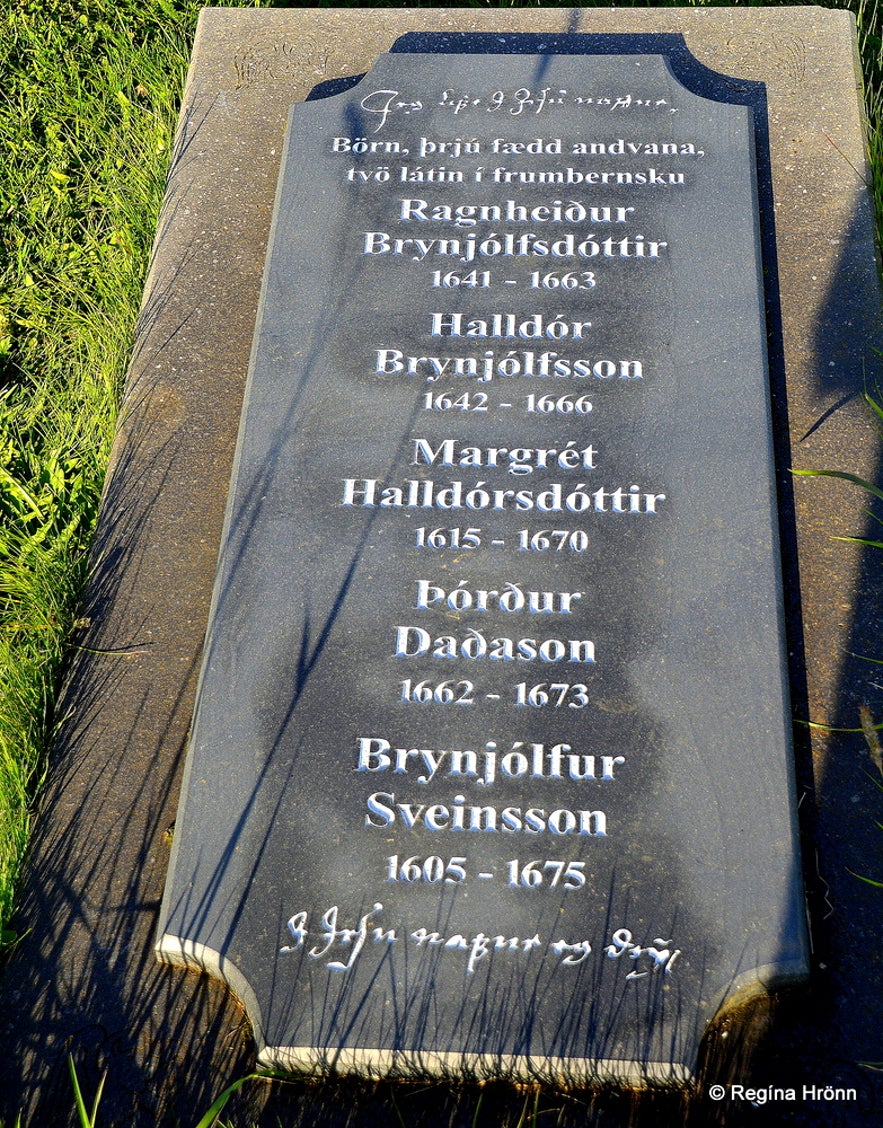 The gravestone of Bishop Brynjólfur and his family
The gravestone of Bishop Brynjólfur and his family
Þórður Daðason was the son of Ragnheiður and Daði (the only grandchild of the bishop) and he died when he was 11. So there was only Brynjólfur the bishop left when he died in 1675.
I attended both an outside and inside evening lecture about the sad fate of Ragnheiður Brynjólfsdóttir, the daughter of Bishop Brynjólfur.
This is such a sad story and in the end, Bishop Brynólfur was left with no descendants.
If only he had allowed his daughter Ragnheiður and Daði to marry each other.
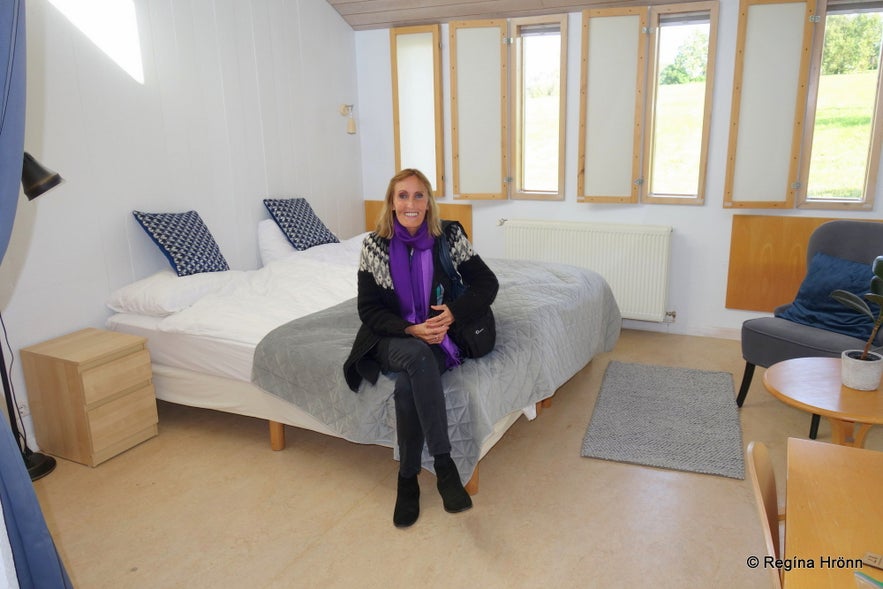
My room at Skálholt
Seeing that it was an evening lecture and Skálholt is approx. 90 km away from Skálholt then I decided to treat myself and stay for the night at Skálholt.
The last time I stayed at Skálholt I was 7 years old so it was about time to stay there again :) It was more expensive than I usually pay for hotels in Iceland, but it was so worth it.
And on the 60th anniversary of Skálholtskirkja cathedral, we were invited to stay in the same cottage in which I stayed when I was 7 years old. He is a magician and was booked to be a part of the entertainment at the celebration.
I love Skálholt and was so privileged and so happy about being a part of Skálholt's history :)
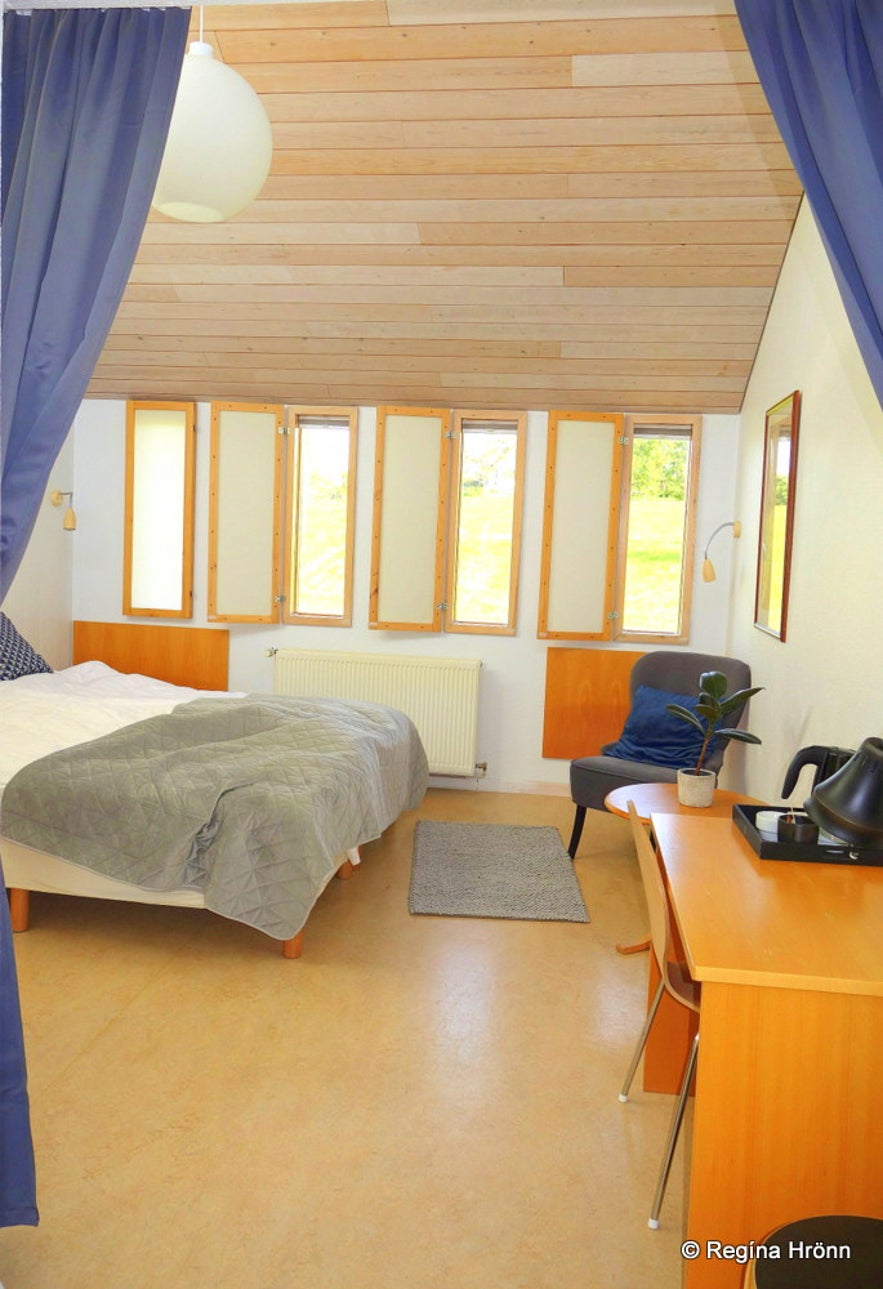 My room at Skálholt
My room at Skálholt
The room in which we stayed is bright and spacious, unfortunately, the view was not of the cathedral, but I stayed outside until the wee hours of the morning and explored Skálholt in the silence of the bright summer night.
The sky was awesome and added to the mystery of the historic Skálholt.
Bishop Jón Arason
The memorial for Jón Arason at Skálholt
A short distance above Skálholt cathedral you will find the memorial for Bishop Jón Arason at Hólar, who was beheaded in 1550 at Skálholt, together with his 2 sons, Björn and Ari.
This tragic event took place during the Reformation, the change from Catholicism to Lutheranism.
The memorial for Jón Arason at Skálholt
Written on it in Icelandic is: "Jón Arason biskup - ljet hjer lífið fyrir trú sína og ættjörð - 7. nóvember 1550" meaning "Bishop Jón Arason - lost his life here for his religion and fatherland on the 7th of November 1550".
 The execution of Jón Arason as depicted at the Saga Museum, which I recommend visiting
The execution of Jón Arason as depicted at the Saga Museum, which I recommend visiting
Jón and his sons were buried here at Skálholt after the execution, but the next spring a party of men from the northern part of Iceland rode to Skálholt.
They meant to take the bodies to Hólar for a proper burial. They exhumed the bodies of Jón and his sons at Skálholt and took them to Torfastaðir for the night.
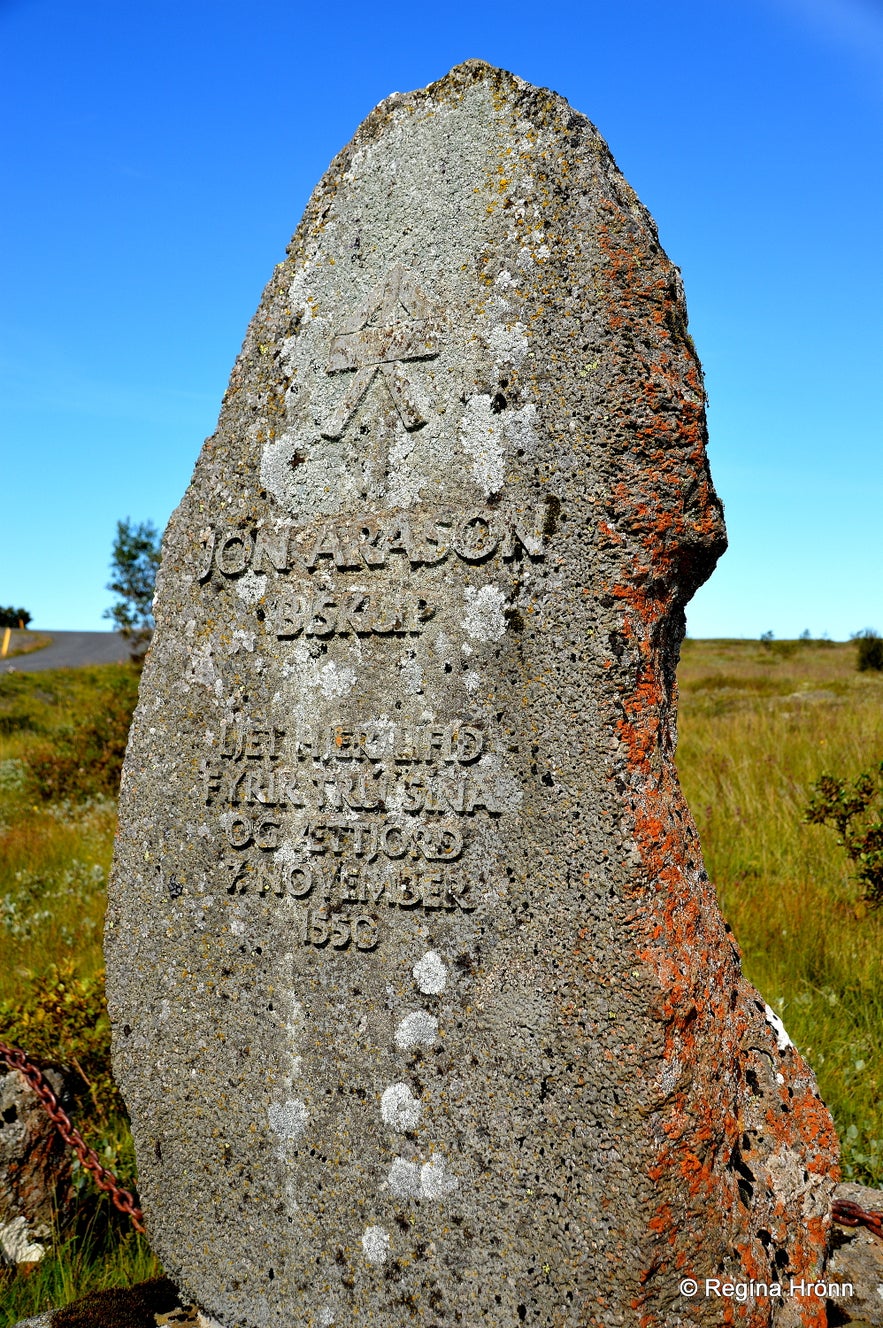
The memorial for Jón Arason at Skálholt
The next day, on their way up north, they washed the mud-covered bodies in the holy spring, Vígðalaug, at Laugarvatn in the vicinity of Skálholt.
The 6 rocks above Vígðalaug, are called Líkasteinar, as the biers were laid on them while the 3 bodies were washed in the holy spring.
Vígðalaug pool - there is no bathing in this pool
Earlier on in history, after the conversion to Christianity in the year 1000 at Alþingi at Þingvellir, some of the Vikings on returning home, got baptized in the Vígðalaug pool.
Some Vikings from the west got baptized in Krosslaug in West Iceland. It was warmer than being baptized in the cold river at Þingvellir.
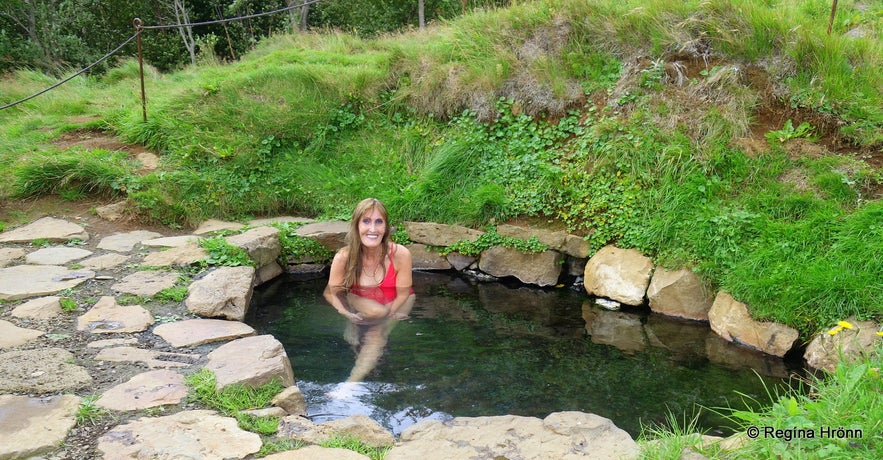
Krosslaug hot pool in West Iceland - I can vouch for the warm temperature of the geothermal water
According to folklore Líkaböng, the largest bell in the Hólar Cathedral started ringing by itself when the party of men with the bodies reached Vatnsskarð pass, where you have a view of Skagafjörður.
Líkaböng continued ringing until the party of men could be spotted from Hólar. Then the bell started ringing so forcefully, that it cracked.
You can see Hólar in my photo below.
See also: the historic Hólar in Hjaltadalur in North Iceland
Hólar in Hjaltadalur valley
I recommend visiting both of these historic places as they are very important places in Icelandic history. To me, Skálholt has a magical touch to it, the energy in Skálholt is very special.
The Cathedral is open every day from 9:00-18:00.
Skálholt is located in South Iceland some 93 km away from Reykjavík and can be included in the Golden Circle tour.
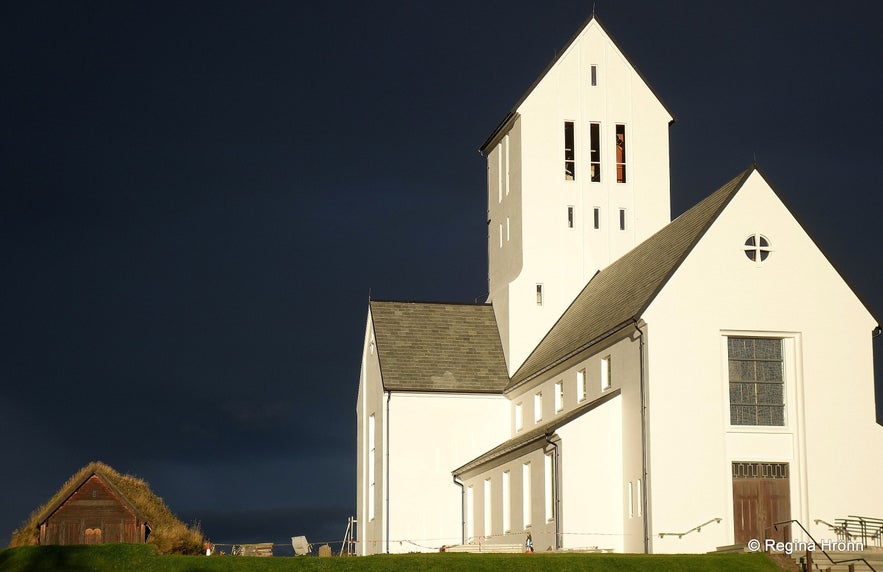 Þorláksbúð and Skálholtsdómkirkja cathedral on a stormy summer day in 2022
Þorláksbúð and Skálholtsdómkirkja cathedral on a stormy summer day in 2022
To visit this area on your own you can rent a car and make a day of it by visiting the highlights of the Golden Circle Gullfoss and Geysir on the same day.
Here is the location of Skálholt on Google maps.
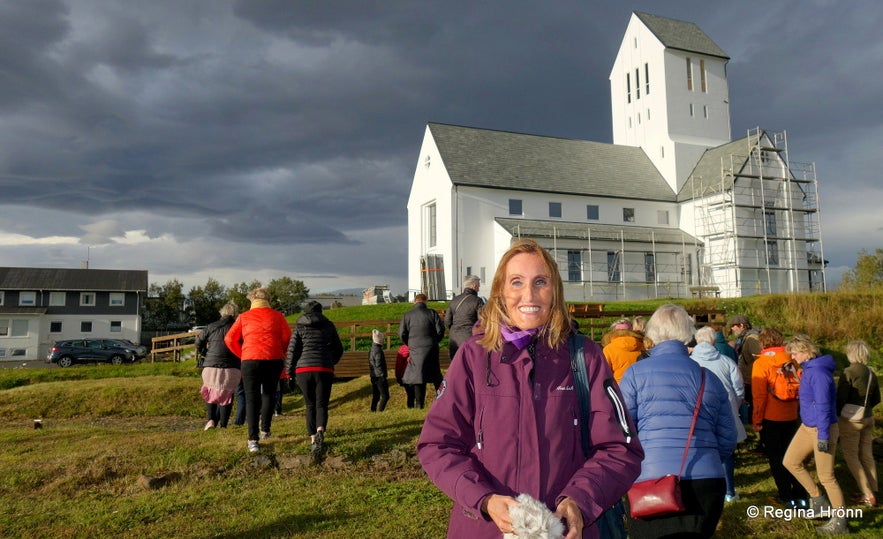 I attended a lecture in Skálholt about the sad fate of Ragnheiður Brynjólfsdóttir
I attended a lecture in Skálholt about the sad fate of Ragnheiður Brynjólfsdóttir
Have a lovely time at the historic Skálholt :)
Source:
Ferlir: Aftaka Jóns biskups Arasonar
Vísindavefur: Siðaskipti á Íslandi og hlutverk Jóns Arasonar í því ferli
Kirkjur Íslands - volume 29 - Skálholtsdómkirkja
기타 흥미로운 블로그
요쿨살론부터 비크까지, 꽃보다 청춘 5화
드디어 하늘씨과 쓰리스톤즈가 합류했는데요! 설원을 달리는 모습에 저도 아이슬란드가 엄청 그리워졌답니다. 빙하와 빛나는 요쿨살론 첫번째로 향한 요쿨살론(Jokulsarlon)은 아이슬란드의 대표적인 명소 중 하나랍니다. 영어로 Glacier lagoon 이라고도 하는데요. 방송에 나온 것처럼 눈 앞에 보이는 빙하는 빙하수가 흘러서 녹았다 얼었다를더 보기스코가포스 폭포부터 오로라까지, 꽃보다청춘 4화를 따라서
여행 5일째, 포스톤즈가 처음으로 향한 곳은 아이슬란드 남부에 있는 스코가포스 폭포(skogasfoss)입니다. 아이슬란드 남부의 대표적인 폭포 중 하나에요. 방송에서는 들르지 않았지만 스코가포스 거의 바로 옆에 위치한 셀리야란드스포스(seljalandsfoss) 폭포와 함께 같이 들르곤 한답니다. 스코가포스 폭포는 폭포의 물줄기 끝까지 올라갈 수 있단더 보기꽃청춘을 따라서
요즘 인기리에 방영되고 있는 꽃보다 청춘 아이슬란드편! 저도 매주 빼놓지 않고 시청하고 있습니다. 많은 분들께서 포스톤즈의 발랄한 매력과 아이슬란드의 놀라운 경치에 빠져드셨을 것 같습니다! 이번에는 꽃보다 청춘을 따라서 아이슬란드를 한번 가보도록 해요! 사실 아이슬란드가 한국에서 그렇게 가기 쉬운 나라는 아닙니다. 거리도 멀고 항공권도 비싸고! 우더 보기

아이슬란드 최대의 여행 마켓플레이스를 전화에 다운로드하여 전체 여행을 한 곳에서 관리하세요
전화 카메라로 이 QR 코드를 스캔하고 표시되는 링크를 누르면 아이슬란드 최대의 여행 마켓플레이스를 주머니에 넣을 수 있답니다. 다운로드 링크가 포함된 SMS 또는 이메일을 받으려면 전화번호 또는 이메일 주소를 추가하세요.


